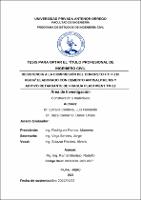Resistencia a la compresión del concreto F C =210 KG/cm“ elaborado con cemento antisalitre MS y aditivo retardante de fragua plastiment TM - 12

View/
Download
(application/pdf: 5.920Mb)
(application/pdf: 5.920Mb)
Date
2023Author(s)
Estrada Cordova, Luis Fernando
Baca Camacho, Daniel Ulises
Metadata
Show full item recordAbstract
En el presente informe de tesis se tiene como objetivos poder determinar el efecto de los
aditivos retardantes plastificantes TM-12 en su resistencia frente a la comprensión del
concreto mostrado en diferentes muestras de edades del concreto f´c = 210kg/cm2. Para
ello, se tuvo una investigación descriptiva, correlacional y cuantitativa. Se consideraron
02 tipos de concreto: Concreto Patrón y Concreto experimental, para el último se tomó
en cuenta dos dosificaciones con el mínimo y el máximo porcentaje de aditivo. Además,
el número de muestras será de 4, para cada tipo de concreto (concentración), a las edades
de 7 días, 14 días y 28 días, haciendo un total de 40 probetas. Con todo ello, se tuvo que:
la Resistencia a la compresión de concreto óptimo y máximo que se puede obtener
(457.9253), para valores óptimos y altos de cada una de las variables independientes como
son: concentración de aditivo (Elemento vaciado = 0.0090) y el tiempo de fraguado de
concreto (Edad del testigo = 28.0). Por ello, se concluyó con el cumplimiento de objetivos
general y específicos The objectives of this thesis was to determines the effect of the plasticizing retarding
additives TM – 12 on the compressives strengths of concrete at differents ages of the
concretes f'c = 210kg/cm2. For this, a descriptive, correlational and quantitative
investigation was carried out. 02 types of concretes weres consideres: Standard Concretes
and Experimental Concrete, for the latter two dosages were taken into account with the
minimum and maximum percentage of additive. In additions, the number of samples will
be 4, for each type of concrete (concentration), at the ages of 7 days, 14 days and 28 days,
making a total of 40 specimens. With all this, it was necessary: the optimum and
maximum concrete compressive strength that can be obtained (457.9253), for optimal and
high values of each of the independent variables such as: additive concentration (Empty
element = 0.0090) and the setting time of concrete (Age of the witness = 28.0). Therefore,
it was concluded with the fulfillment of general and specific objectives
Subject
Collections
- Ingeniería Civil [1260]

